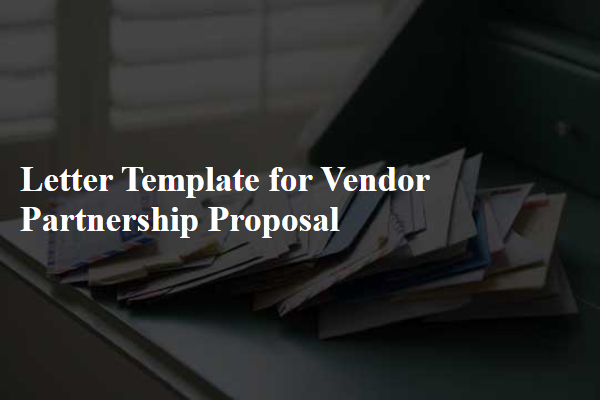Are you considering enhancing your business through strategic vendor partnerships? Crafting the perfect proposal is essential, as it sets the tone for collaboration and mutual growth. In this article, we'll guide you through creating a compelling letter that showcases your vision, outlines benefits, and paves the way for a successful alliance. Dive in with us to discover tips and templates that will streamline your proposal process!

Company Introduction and Background
[Company Name], founded in [Year] in [Location], specializes in [industry or field], with a commitment to delivering high-quality [products/services]. With a dedicated team of [number] professionals, we leverage innovative technology and market insights to enhance customer satisfaction. Our extensive experience spans over [number] years, positioning us as a trusted leader in the industry. We emphasize sustainable practices, maintaining partnerships with key suppliers and clients to ensure mutual growth and stability. Recent collaborations with [notable partners or brands] have strengthened our market presence, leading to a [percentage] increase in sales and customer engagement. Our mission focuses on [core mission/goals], emphasizing adaptability and forward-thinking strategies to respond to evolving market demands.
Proposal Overview and Objectives
A vendor partnership proposal highlights the strategic collaboration between two entities aimed at mutual benefits such as increased revenue and market reach. Key components of this overview include the identification of target markets, specific services or products to be offered, and anticipated growth metrics. Establishing a clear objective, like boosting sales by 20% within the first fiscal year, is crucial. Additionally, defining the partnership's unique value proposition, such as exclusive promotions or bundled offerings, reinforces potential advantages. Collaboration expectations, like joint marketing efforts or regular progress assessments, enhance clarity and commitment, setting a solid foundation for a successful partnership.
Benefits and Value Proposition
A robust vendor partnership proposal highlights key benefits and value propositions essential for mutually beneficial collaboration. Establishing a strategic alliance can lead to cost reductions, enhanced supply chain efficiency, and access to innovative resources or technology. By leveraging each other's strengths, such as a vendor's manufacturing capabilities or a partner's distribution network, companies can maximize market reach and improve service offerings. Additionally, shared expertise can foster creativity, driving product development and quality improvements. Furthermore, joint marketing initiatives can increase brand visibility, position both organizations favorably within the market, and ultimately lead to higher revenue growth and customer satisfaction.
Partnership Terms and Expectations
A vendor partnership proposal outlines the collaboration terms between parties aiming for mutual growth and success. Key elements typically include defined roles, responsibilities, and performance metrics. Specific expectations, such as minimum order quantities and timely delivery schedules, are crucial for operational efficiency. Financial aspects encompass pricing strategies, payment terms (30 days net after delivery), and potential discounts for bulk purchases. Regular communication schedules allow for addressing challenges and opportunities (monthly review meetings). Partnership evaluation criteria, like customer satisfaction scores (target of 90% or higher), help measure effectiveness. Clarity in confidentiality agreements protects sensitive information shared during the partnership.
Contact Information and Call to Action
Strategic vendor partnerships can enhance business performance and drive growth potential. Effective communication (including email, phone, or official address) is critical for maintaining a strong relationship. Clear expectations for collaboration and mutual benefits must be articulated. Invitations for follow-up discussions or meetings can encourage engagement, ensuring alignment on goals and objectives. A well-defined proposal should include a specific call to action, prompting potential vendors to respond within a specific time frame, such as 14 days, to facilitate timely discussions and decision-making.
Letter Template For Vendor Partnership Proposal Samples
Letter template of a vendor partnership proposal for technology solutions.

Letter template of a vendor partnership proposal for supply chain management.

Letter template of a vendor partnership proposal for marketing services.

Letter template of a vendor partnership proposal for construction services.

Letter template of a vendor partnership proposal for software development.

Letter template of a vendor partnership proposal for janitorial services.








Comments